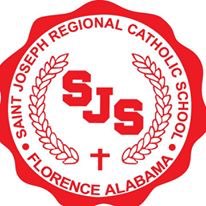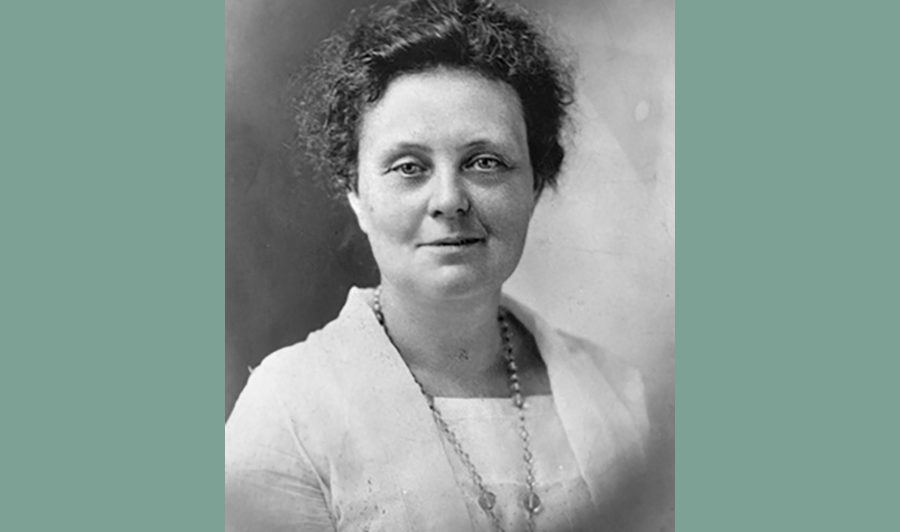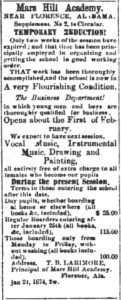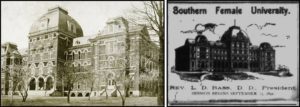Higher education, private teachers, libraries, denominational sponsorship, and expansion of educational opportunities help to define this period of growth.
1855 – The Florence Synodical Female College – The Florence Synodical Female College is charted under the aegis of the Nashville Synod of the Presbyterian Church in the old Florence Female Academy building. Dr. James L. Rogers is the first president of the school.

Photo from the Florence Lauderdale Public Library Digital Archives
January 1855 – Florence Wesleyan University – LaGrange College moves from Leighton, Alabama to Florence. Classes are held in the downtown Masonic Hall. The school is initially referred to as LaGrange College at Florence. Unable to retain the name LaGrange for legal reasons the Tennessee, Memphis and Alabama Conferences of the Methodist Church charter the school under the new name of Florence Wesleyan University on February 14th. Dr. Rivers continues to serve as President.
May 26, 1855 – Mr. Goodwin – Mr. Goodwin opens a dancing and calisthenics class for both the ladies and gentlemen of Florence at a charge of $10.
October 1, 1855 – Prof. Lambert – Porf. Lambert opens a Private French Class for Ladies and Gentlemen. He will give lessons at his class-room or at the residence of the student.
1861 – Sixth Ward School – Sixth Ward School is established (later becomes the Brandon School).
October 29, 1866 – Freedman’s Public School (The Colored Free School), under the auspices of the Pittsburg Freedmen’s Aid Commission and taught by black educator Oscar M. Waring, opens at Church Springs ME Church (now Greater St. Paul AME Church) in Florence.
Photos: L, Photo of noted educator Oscar M. Waring (1841-1911), back row, far left, with several of his colleagues in St. Louis in 1900. Waring was the first principal of Florence’s Freedmen’s Public School, which was founded in 1866 at St. Paul AME Church by the Pittsburgh Freedmen’s Aid Commission. It’s mission was to educate the children of Florence’s freed slaves. R, article on Jake Thompson’s school on Peter Broadfoot’s place at the Bend of the River, stating that Jake had a 60 year-old student, “Aunt” Mariah Koger, who was learning to read, from the *Florence Gazette*, Sat., March 13, 1880, p. 3
1868 – W. D. Willis School – Professor W. D. Willis organizes a High School that opened in Wesleyan Hall (which is now part of the University of North Alabama campus). It lasted for 5 years.
1870 – Ann Stevens School – Miss Ann Stevens from Ireland is the teacher of a school located on Pine Street.
1871 – Ray School – Miss Mattie Ray is the teacher of a school on the north end of Court Street.
January 1, 1871 – Mars Hill Academy for Males and Females – On January 1st, Tennessee native and Christian Church/Church of Christ evangelist Elder Theophilus Brown “TB” Larimore, with the legal assistance of his brother-in-law, Irish native, attorney, and Lauderdale County Circuit Court Clerk John A Thompson, opens Mars Hill Academy for Males and Females (later Mars Hill College) on 21 acres of land 5 mile north-east of Florence (near St. Florian), on land inherited by his wife, Julia Ester Gresham. The School will operate for 17 years.
Photo: Advertisement for Mars Hill Academy for Males & Females from the *Florence Times-Journal,* Tuesday, January 21, 1874, p. 3.
May 15, 1871 – German Night School – The German Night School for young men opens and is taught by Professor Theo. Colere. Tuition for the Professor’s German School is $2 per month.
July 1872 – Leigh School – In late July, Mrs. Susan Watson Leigh, wife of Leighton founder Rev. William Leigh and retired matron of the Presbyterian Female Synodical College, founds in her home on North Market Street (now 747 North Wood Avenue, known as the J.J. Mitchell House) the Maternal School, for young girls deprived of a mother’s influence, a school between the [orphans’] asylum and the young ladies’ seminary, which offers boarding accommodations. The school operates until her death on July of 1874.
1875 -At State Normal School – State Normal School became one of the nation’s first coeducational colleges when women were permitted to attend beginning in the spring.
1876 – Carpenter School – Carpenter School – The Congregationalists of New York open a Colored school in Florence which will be known as the Carpenter School.
July 1878 – Catholic School in Florence – The completion of the Catholic School in Florence.
September 2, 1878 – Miss Janie Thomson’s Select School – Miss Janie Thomson’s Select School begins.
1882 – Waters School – Mrs. Bettie Waters is the teacher of a school in a small brick building where the Patton School is now.
1885 – Kilby School – Kilby School was established and accepted its first students in 1886. It began as a training lab for future teachers at State Normal School.
1885 – Ticksville School – Ticksville School near Green Hill was a one-room log cabin. the teacher was the the mother of Allen Thornton, the Lauderdale County Superintendent of Education in 1964.
1885 – The Ladies’ Library – The Ladies’ Library, Florence’s first library is organized. It was a subscription library. Its funding came through membership dues of $1.00 a year. This was supplemented by various fund-raising projects, such as plays and concerts.
1887 – State Normal College – State Normal School changes its name to State Normal College.
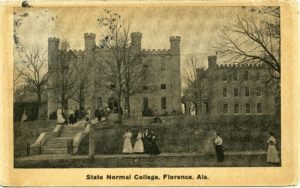
Photo from the Florence Lauderdale Public Library Collection
1887 – Mars Hill College – Christian Church/Church of Christ evangelist Elder Theophilus Brown “TB” Larimore closes Mars Hill College (formerly Mars Hill Academy for Males and Females) after 17 years in order to preach full time.
July 6, 1889 – Ladies’ Library Association – The Ladies’ Library Association advertises their library will be open every Thursday evening between 5:00 pm and 6:00 pm at the Presbyterian Synodical College. This was the city’s first Public Library.
December 18, 1889 – Southern Female University – The contract for the Baptist Southern Female University on Seymour Avenue is let to J. B. Alliger. It calls for the building to be completed by October 1890, at a cost of $60,000. The building will be 210 feet long, 121 feet wide, five stories high and contain 125 rooms, including 38 classrooms, 16 recitation rooms, 50 dorm rooms for students, and a two-story chapel seating 750. The actual cost of the building is $80,000.
L, The Southern Female University building from the 1910-1911 catalog of the Florence University for Women, which succeeded the SFU in 1908. R, A newspaper “card” or advertisement, for the Southern Female University from the *Florence Herald* of Wednesday, September 16, 1891, p. 1.
1890 – Florence Classical, Business and Military School – Florence Classical, Business and Military Academy (boys only) began in the City Hall building (now a parking lot on Short Court Street). Professor Alex S. Paxton was the Teacher/Principal.
May 30, 1890 – Lauderdale County Colored Teachers Institute – May 30th, and 31st, Lauderdale County Colored Teachers Institute convenes at the courthouse in Florence, with Professor Young A. Wallace and T.J. Austin presiding.
August 25, 1890 – Patton School -The cornerstone of the Patton School is laid in an impressive ceremony.
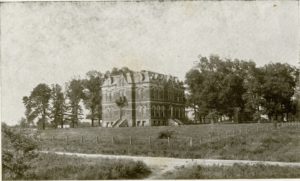
Photo from the Florence City Schools Archives
1891 – Sixth Ward School – Sixth Ward School in East Florence opens with T. B. Scruggs teaching.
1891 – 1897 – Prof. A. S. Paxton – Prof. A. S. Paxton, a Virginia native and a graduate of Washington and Lee University, teaches a Preparatory School for boys on Alabama Street. The school moved to the present Jefferson Hotel building for its last year in 1897.
1891 – Fifth Ward/Seven Points School -Fifth Ward/Seven Points School opens with T. J. Bond teaching.
1891 – Colored Public Free School – Colored Public Free School on Court Street opens with Young A. Wallace Principle.
1891 – Patton School – In October, Patton School opened. It was named for Gov. Robert M. Patton who owned the Sweetwater Plantation. It was located on College Street between Cherry and Chestnut Streets.
February 18, 1891 – A Separate School District – An act to create a separate school district in the city of Florence is approved.
June 19, 1891 – Miss Mary Smith’s School – Miss Mary Smith’s School on Royal Ave. has its closing exercises.
September 15, 1891 – Southern Female University – Southern Female University opens with sixty-three students.
October 1892 – Southern Female University – The Southern Female University relocates to Birmingham.
1893 – The Ladies Library – The Ladies Library moved to City Hall after the closing of Florence Synodical College.
1893 – 1900 – Bailey Springs University -Bailey Springs University is established for the higher education of women and operates at the resort. A free tuition in all departments is offered to 36 Alabama girls between the ages of 14 and 24. In 1894 the University is incorporated with the approval of the state legislature and operates until 1900.
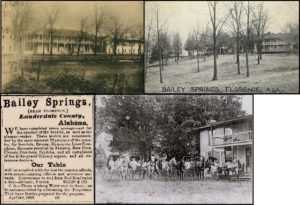
Photos: Scenes of Bailey Springs, Clockwise from L, the Resort ca. 1880s; the Resort ca. 1890s from an old post-card; guests at the Resort ca. 1897; an ad for the resort from the *Florence Gazette,* Wednesday, May 23, 1860, p. 3.
1895 -At State Normal College – At State Normal College, the 1895-96 catalog makes first mention of a library separate from those of the literary societies; by 1897 it will contain approximately 400 volumes.
1896 -Young Men’s Christian Association’s (YMCA) Library – The local chapter of the Young Men’s Christian Association (YMCA) maintained a library which was staffed by a librarian. This library was open on Sunday afternoons from 2 to 5 p.m. The young men of Florence who were members of the YMCA were encouraged to use this library.
September 1896 – The YMCA and Ladies Library – In September, an unsuccessful attempt was made by the local chapter of the YMCA to combine its facilities with the Ladies Library to establish a unified public library for Florence. They proposed that the combined library facilities be named the Confederate Memorial Library as a memorial to the Confederate soldiers who had given their lives during the Civil War.
1897 -Corpier School – A colored school under the auspices of the American Missionary Society is being taught in the Canaan subdivision of southwest Florence. The teacher is a Florence native and graduate of Fisk University Miss Mary Corpier.
1898 – Florence Free Kindergarten – September, The Florence Free Kindergarten, the pioneer free kindergarten of Alabama, is founded by Miss Loulie Jones at the Sloss-Sheffield Furnace commissary. The kindergarten moves into the basement of the new Charles M. Brandon School after it is completed. Miss Maud Lindsay and Miss Blanche Moore are hired as teachers. Songs, games, and stories created by Miss Lindsay and other teachers are still used today in the school.
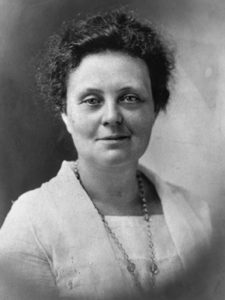
Miss Maud Lindsay
Photo from the Florence City Schools Archives
May 7, 1898 – Southern Library Association – The week of Monday, May 7th, the Ladies’ Library of Florence incorporated as the Southern Library Association. The Library comprises 2,000 volumes.
September 3, 1898 – The Florence Free Kindergarten Club – The Florence Free Kindergarten Club was founded by Miss Loulie Jones in the home of Mrs. John R. Price. Its aim was to promote in every way possible the welfare of the children of Florence and to maintain a free Kindergarten in East Florence.
1899 – Sixth Ward School Named – The new Sixth Ward East Florence School was named (Charles M.) Brandon (Elementary) School after industrialist and philanthropist the late Charles M. Brandon who was also superintendent of the Cherry Cotton Mills.
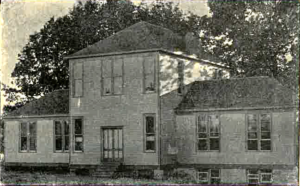
Photo from the Florence City Schools Archives
May 22, 1899 – St. Joseph’s Catholic Parochial School – St. Joseph’s Catholic Parochial School holds its first closing exercises.
